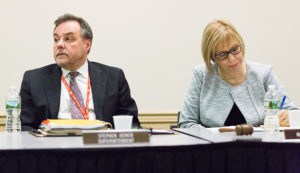
JACKSON – In years’ past, schools’ Superintendent Stephen Genco has said the district’s nearly $150 million budget more than covered everything that the administration wanted to see accomplished.
That’s not the case this year.
While no programs or staff are being cut, some maintenance projects were dumped and departments across the board felt a 10 percent reduction in their budgets, all to ensure that the state-mandated 2 percent cap was not exceeded.
The budget introduced at the board of education’s March 21 meeting was $150.2 million, increased from $148.8 million, up .9 percent. Although the administration will continue working on its final numbers now until the public hearing on April 25, communications coordinator Allison Erwin told members of the press the figures and final totals will not drastically change.
The average homeowner may see a $30 increase in their school taxes, Genco said.
But he also said the district is very close to that very real “fiscal cliff,” one it finds itself teetering on. The district saw its state aid slashed in 2009 and frozen where it is. About 60 percent of the total budget comes from the local tax levy – which increased $2.2 million from $79.2 million to $81.4 million – and the other 40 percent from state and federal aid.
The district will receive $50.7 million in state aid for the 2017-18 school year.

The athletics and co-curricular budgets, presented by athletic director Rob Paneque and assistant superintendent Nicole Pormilli respectively, saw very little change from the previous year’s budgets. The athletics budget dropped nearly $7,000 to $489,489. The co-curricular budget was $434,237 for the 2016-17 school year. That budget cannot be completed until contract negotiations are done.
Business Administrator Michelle Richardson gave presentations for the buildings and grounds, as well as the transportation budgets. The administration cut its Tier 1 project list—projects considered imperative – by $344,000 to stay within budget confines. Projects like security vestibules were trimmed.
The district has found savings in its energy budget, which Richardson, who said it was a “slight risk,” cut $316,666 from $3 million to $2.7 million. The district’s energy initiatives, headed by energy education specialist John Blair, along with a mild winter, helped decrease that budget.
An area of concern is out of district busing, which has seen exponential increases in just a couple years. The district spent $101,935 in 2015-16 for that busing; that figure is projected to be $610,100 for the 2017-18 school year, and that may not be enough to cover those costs.
 The district receives aid in lieu of transportation (AIL) for these students from the state. Richardson said the district has 409 students who receive Aid In Lieu of funds, although she is still going through applications and that number will likely increase before the end of the school year. She is projecting the district will have 690 AIL students next school year.
The district receives aid in lieu of transportation (AIL) for these students from the state. Richardson said the district has 409 students who receive Aid In Lieu of funds, although she is still going through applications and that number will likely increase before the end of the school year. She is projecting the district will have 690 AIL students next school year.
Families who send their children to private schools 2 to 20 miles from their homes are entitled to busing. If the district cannot provide transportation, it must pay those families $884 per child to cover the cost of transporting their children themselves. There wasn’t a breakdown available of where those students attended school.
Board member Thomas Colucci asked if the AIL is becoming unmanageable.
“It’s not unmanageable, but we have to manage it,” Richardson said. “It’s the law.” The district needs to find ways to not take money away from their public school students’ educations, she added.
The budget hearing is scheduled for 6:30 p.m. on April 25 in the Jackson Memorial High School Fine Arts Auditorium.







